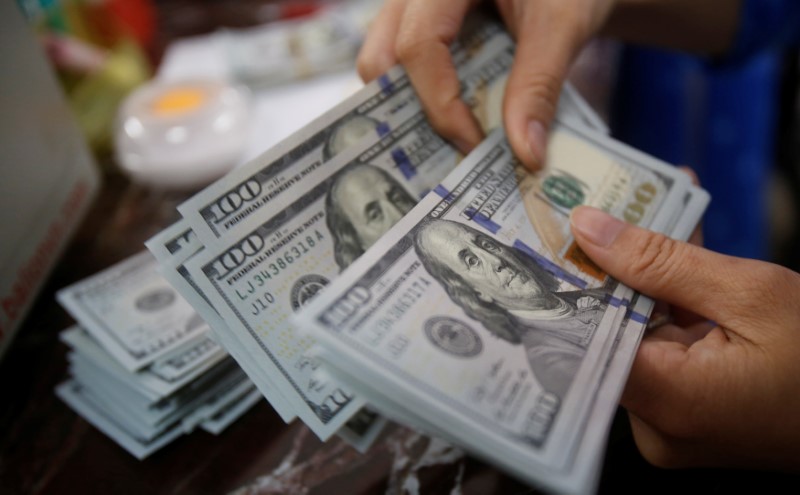* Yen hits three-week low
* Kiwi slips as RBNZ again mentions negative rates
* Fed speakers eyed after easing hints in minutes
* Graphic: World FX rates in 2020 https://tmsnrt.rs/2RBWI5E
By Tom Westbrook
SINGAPORE, Oct 8 (Reuters) - The safe-haven dollar and
Japanese yen nursed losses on Thursday, after the revival of
hopes for some U.S. stimulus spending improved investor
sentiment, while the prospect of negative interest rates dragged
on the New Zealand dollar.
President Donald Trump and House Speaker Nancy Pelosi seem
open to pursuing a stimulus package for the airline industry,
despite Trump halting talks with Democrats for a bigger plan.
Investors also expect a Joe Biden administration, if
elected, would quickly spend money to stimulate growth.
That mood has lifted equity markets and sunk the safe-haven
yen JPY= to a three-week low of 106.11. The dollar struggled
to recoup losses against other majors, excluding the kiwi.
The euro EUR= edged up to $1.1770. The risk-sensitive
Australian dollar AUD=D3 held Wednesday gains. AUD/
"Perhaps the market is a bit more relaxed about the fiscal
stimulus story," said Bank of Singapore currency analyst Moh
Siong Sim.
"We might not get fiscal stimulus pre-election, but if polls
are right, and we see a Democratic sweep, we will likely get
fiscal stimulus late in the year or early next year."
With no new news on the stimulus front, and Chinese markets
still closed, volumes were lightened and moves slight in Asia.
The New Zealand dollar NZD= was the biggest loser among
G10 currencies, dropping as far as half a percent after central
bank officials again hinted that negative interest rates are in
the offing. Money-market pricing of an April 2021 rate cut deepened
after the remarks and the kiwi slipped to a three-week low
against the Aussie AUDNZD= , before paring losses a little.
It was last down 0.2% against the dollar at $0.6570.
"Today's rhetoric from the RBNZ leaves us of the view it
will cut the official cash rate into negative territory before
too much longer," BNZ economist Craig Ebert said in a note,
forecasting rates at -0.50% later in 2021, from 0.25% currently.
FED SPEAKERS ON RADAR
A buoyant mood in equity markets was also supported by hints
at even more easing from the U.S. Federal Reserve.
September meeting minutes released on Wednesday showed many
participants had assumed the economy would be supported by
fiscal spending, and some are open to further debate about the
Fed's bond buying programme. "This nuance did not come across in Powell's post-meeting
press conference nor in recent speeches," National Australia
Bank economist Tapas Strickland said in a note on Thursday.
"In that vein it is worth noting that the Fed's (Loretta)
Mester on Monday said she might support shifting asset purchases
to more longer-dated bonds."
It has also focused investor attention on speeches from Fed
members Eric Rosengren and Raphael Bostic, at 1610 GMT and 1800
GMT respectively, for any further hints at the Fed's thinking.
Elsewhere the U.S. vice presidential debate did not move
currency markets, but reinforced investors' expectations on the
policy settings that Trump or Biden administrations would hold.
"Pence reiterated his hardline stance against China ...
meanwhile, Senator Harris said Trump lost the trade war with
China," said Mizuho's chief Asia FX strategist Ken Cheung.
"That says Biden's victory should mitigate the risk of
resuming the trade war, which could prompt the People's Bank of
China to allow yuan depreciation again to counter the tariffs
impact," he said.
He expects the onshore yuan to be fixed around 6.79 per
dollar when trading resumes after a week-long holiday in China
on Friday - more or less steady despite a weaker dollar.
The yuan last traded at 6.7898 onshore CNY= and is at
6.7389 in offshore trade CNH= .
Sterling GBP= , weighted by concerns that the latest Brexit
talks were proving less promising than hoped, lagged other
majors' gains on the greenback and was steady in Asia at
$1.2928.
Bank of England Governor Andrew Bailey is due to speak at
0725 GMT and remarks on negative rates or other policy
considerations could move the currency.
